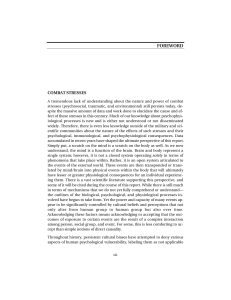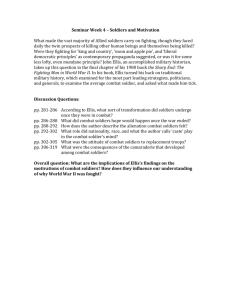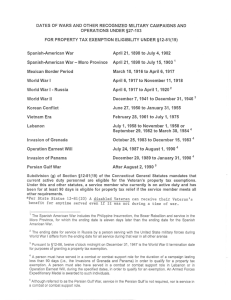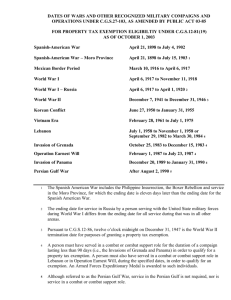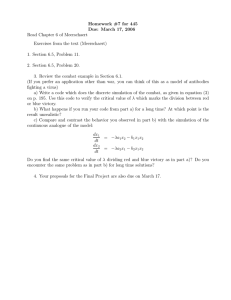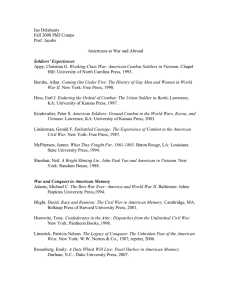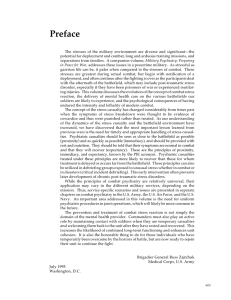RETURN FROM THE PERSIAN GULF AND ITS CONSEQUENCES
advertisement
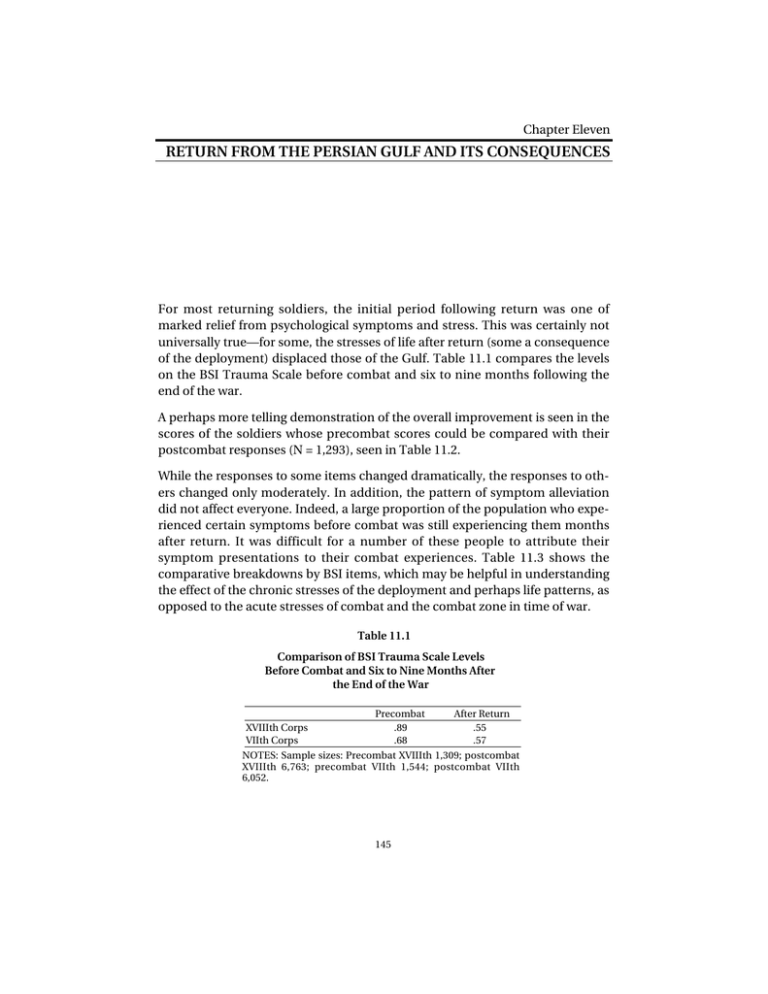
Chapter Eleven RETURN FROM THE PERSIAN GULF AND ITS CONSEQUENCES For most returning soldiers, the initial period following return was one of marked relief from psychological symptoms and stress. This was certainly not universally true—for some, the stresses of life after return (some a consequence of the deployment) displaced those of the Gulf. Table 11.1 compares the levels on the BSI Trauma Scale before combat and six to nine months following the end of the war. A perhaps more telling demonstration of the overall improvement is seen in the scores of the soldiers whose precombat scores could be compared with their postcombat responses (N = 1,293), seen in Table 11.2. While the responses to some items changed dramatically, the responses to others changed only moderately. In addition, the pattern of symptom alleviation did not affect everyone. Indeed, a large proportion of the population who experienced certain symptoms before combat was still experiencing them months after return. It was difficult for a number of these people to attribute their symptom presentations to their combat experiences. Table 11.3 shows the comparative breakdowns by BSI items, which may be helpful in understanding the effect of the chronic stresses of the deployment and perhaps life patterns, as opposed to the acute stresses of combat and the combat zone in time of war. Table 11.1 Comparison of BSI Trauma Scale Levels Before Combat and Six to Nine Months After the End of the War Precombat After Return XVIIIth Corps .89 .55 VIIth Corps .68 .57 NOTES: Sample sizes: Precombat XVIIIth 1,309; postcombat XVIIIth 6,763; precombat VIIth 1,544; postcombat VIIth 6,052. 145 146 Psychological and Psychosocial Consequences of Combat and Deployment Table 11.2 Panel Study Mean Trauma Scale Scores Precombat .52 Postcombat .74 NOTE: Sample number equals 1,293. Table 11.3 Selected Precombat and Postcombat BSI Item Responses to the Question, “How Much Discomfort Did This Problem Cause You During the Past Week?” (in percentages of panel study sample) Item Nervousness or shakiness inside Precombat Postcombat Reported unpleasant thoughts Precombat Postcombat Faintness or dizziness Precombat Postcombat Loss of sexual interest Precombat Postcombat Trouble remembering things Precombat Postcombat Feeling easily annoyed or irritated Precombat Postcombat Feeling low in energy or slowed down Precombat Postcombat Temper outbursts that you could not control Precombat Postcombat Feeling blue Precombat Postcombat Postcombat Hot or cold spells Precombat Postcombat Numbness or tingling in parts of your body Precombat Postcombat Trouble concentrating Precombat Postcombat None A Little Bit Moderate Quite a Bit Extreme 65.1 73.8 21.0 16.9 8.8 5.9 3.5 2.2 1.7 1.3 41.7 67.2 28.4 17.4 14.0 8.1 9.2 5.2 6.7 2.1 89.7 88.9 5.4 7.7 3.4 2.6 .7 .3 .7 .5 70.2 86.3 7.6 7.0 8.7 3.4 5.2 1.8 8.3 1.4 64.6 63.2 21.5 20.2 7.8 8.6 3.4 5.5 2.6 2.5 25.3 47.5 27.7 22.2 19.7 11.3 14.8 10.9 12.5 8.1 52.5 57.2 26.7 21.6 10.8 10.2 5.9 7.5 4.1 3.5 52.0 69.5 19.0 14.7 12.2 8.0 9.8 3.8 7.1 4.1 40.0 61.3 65.7 25.5 18.7 16.9 14.0 8.3 7.8 10.6 7.0 6.5 10.0 4.7 3.1 85.3 87.1 8.2 7.3 3.9 3.5 .8 1.4 1.8 .7 77.4 82.4 11.6 9.5 5.3 3.9 3.1 2.5 2.5 1.8 61.1 63.5 22.0 20.8 9.8 8.3 4.1 5.6 2.9 1.9 Return from the Persian Gulf and Its Consequences 147 Table 11.3—continued Item Feeling weak in parts of your body Precombat Postcombat Feeling tense or keyed up Precombat Postcombat Sleep that is restless or disturbed Precombat Postcombat Feeling so restless you couldn’t sit still Precombat Postcombat NOTE: Sample number equals 1,273. None A Little Bit Moderate Quite a Bit Extreme 71.7 72.1 15.0 15.2 7.7 7.6 3.3 3.3 2.3 1.8 48.9 61.6 21.7 18.0 13.5 9.9 9.0 6.4 6.9 4.1 51.4 65.0 19.2 16.7 10.3 8.1 9.7 5.7 9.4 4.5 72.3 70.1 14.6 14.5 6.6 8.0 3.6 4.6 2.9 2.7 It is equally important to point out that a number of symptom categories hardly change at all. This appears to be particularly true for those with somatic and cognitive aspects. Most of those who presented high levels of symptoms in the precombat period presented high levels of like symptoms in the postcombat period. THE EFFECTS OF TRAUMATIC EXPOSURE TO COMBAT Those soldiers who were highly symptomatic after combat included a high proportion of those who were highly symptomatic before combat and others whose symptom profiles while low in the precombat period had risen in the postcombat period and who claimed high levels of combat exposure. In general, the more traumatic combat events the soldier was exposed to, the higher his probable score on the Trauma Scale or the Global General Severity Index of the Brief Symptom Inventory. Those events historically and usually classified as highly traumatic include loss of a unit member, exposure to American dead and wounded, perception that one’s own life was in imminent danger, exposure to incoming artillery fire, exposure to mines/booby traps, and exposure to enemy and civilian dead.1 However, factors other than traumatic events or exposure to combat seem to have been involved for the majority of those in the sample who continued to show high levels of symptoms after return. Once again, it must be pointed out that those who had high BSI scores before combat were most likely to be those with equivalently high scores postcombat. Unfortunately, we have no data for these specific people “at rest” in a state of ______________ 1 The same pattern and the same “J” curve distribution holds for soldiers whose exposure was to less-traumatic, standard-combat events, such as exchanging fire with the enemy. 148 Psychological and Psychosocial Consequences of Combat and Deployment comparative “normalcy,” i.e., dealing only with the routines and stresses of garrison, training, family, and personal life. What can be said, however, is that response to the subacute chronic stresses of the deployment reasonably predicted the response to the acute stresses of the combat period and response to the stresses that followed return home. Exposure to the acute stresses of combat trauma appears to have increased the risk for various symptoms associated with a posttraumatic stress symptom complex and possible risk for PTSD. The more intense responses to the chronic stresses of the deployment predicted, for a significant part of the sample, a higher level of discomfort, expressed in a set of general psychological symptoms (as seen in the BSI). Thus, high response on the BSI to the stresses of the deployment was, in general, followed by high response of the stressfulness of the combat period, and by high responses to the stresses of the return period. This is shown in the data from the panel study cited above. When the population is divided into quartiles based on BSI scores at time 1 (precombat) and time 2 (postcombat), we see that 55 percent of those who were in the highest quartile (most symptomatic) at time 1 are in the highest quartile at time 2. Of those who were in the second highest quartile at time 1, 20 percent are in the highest quartile at time 2. Those who were in the lower quartiles at time 1 and who moved into the highest ones tended to be soldiers who claimed extensive traumatic exposure in combat. This precombat and postcombat relationship is underlined by the strong relationship that was found between precombat Trauma Scale scores and postcombat reports of traumatic stress symptoms. Based upon the instruments used in the postcombat surveys, a set of algorithms to determine risk for a possible diagnosis of posttraumatic stress disorder was developed.2 Eleven and a half percent of the 1,249 individuals for whom we had complete data in the panel study fell into the moderate- or high-risk groups when surveyed in the period 6 to 12 months after combat. Of these soldiers, 57 percent (52 percent of the moderate-risk group, and 69.2 percent of the high-risk group) had scores in the highest quartile of the BSI Trauma Scale before combat. The numerical distributions are shown in Table 11.4. The percentage of soldiers seen as possibly being at risk for PTSD in the panel study was slightly lower than the percentages generated by the algorithm for the entire sample postcombat. 3 In this cross-sectional view, the most significant ______________ 2 The algorithms were developed by Major Paul Bartone and Charles Hoover, then both of the Department of Military Psychiatry of the Walter Reed Army Institute of Research. They drew on item responses to the BSI, the Horowitz Impact of Events Scale, and the Combat Exposure Scale. The algorithms were designed to indicate individuals who might be at high and moderate risk for such a diagnosis based upon the number and intensity of responses. 3 XVIIIth Airborne Corps (N = approximately 5,500) and VIIth Corps samples (N = also, approxi- mately 5,500). In the former, 12.1 percent of the population was indicated to be at “moderate risk” Return from the Persian Gulf and Its Consequences 149 Table 11.4 Precombat Trauma Scale Quartile Placement of Individuals Meeting Criteria of PTSD Risk Algorithms Moderate-risk group Highest-risk group Lowest 5 4 Second 16 2 Third 29 6 Highest 55 27 correlate of “risk” was the combination of traumatic combat exposure and the intensity of reaction to such exposure. The panel study data indicate that we must be chary about singular assignment of causality and that a preexisting pattern of response to environmental stressors appears to play a significant role in the “illness outcome” equation. This multifactorial view of possible causality and at least partial process control of illness patterns will be discussed in the conclusions of this report. THE STRESSES OF RETURN FROM THE PERSIAN GULF Return from an overseas tour, whether from war or from long-term deployment, is not stress- or hassle-free. Those returning from the Gulf, fortunately, were welcomed back as heroes. Thus, they were not subject to the possible additional risk factors that may have resulted from the rejection and hostility that greeted numbers of Vietnam returnees. Additionally, as opposed to Vietnam, the services brought their people home as units rather than as isolated individuals, which ensured a pattern of continuing social support for many.4 While it was recommended that all soldiers participate in small-group debriefings after combat and prior to their return, this was not done extensively. The intent had been to deal with any events or emotional issues experienced during the deployment and/or combat that might have possible unsettling sequelae. As with a number of issues, making time and places available for such debriefings was up to unit commanders, particularly at the brigade and battalion level. Many apparently did not attend to it.5 However, after the Gulf War there were extensive outreach programs about the very real psychosocial problems that ________________________________________________________________________ and 3.4 percent at “high risk.” In the latter population, 10.4 percent was indicated as at “moderate risk” and 2.5 percent as at “high risk.” 4 This was not the case for all however. Fillers left the units with which they had served in the Gulf immediately upon arrival in either the United States or Germany to return to their original units. 5 Others, according to material developed in our background interviews, had reportedly invoked the widespread “folk psychological belief” that when people talk about bad things it makes them sick and unhappy. In several cases, division-level senior personnel had actively discouraged their mental health staffs from setting up outreach or intervention programs. This was by no means new. Following Operation Just Cause in Panama, a number of commanders had forbidden active consultation or outreach programs to the units involved. Only those in the Ranger Battalions had programs to deal with the possible sequelae of traumatic combat exposure. 150 Psychological and Psychosocial Consequences of Combat and Deployment might occur upon reunion with spouse and family. The services had learned from a long history of experience and research that there was a potential dark side in the reestablishment of familial relationships following return from extended deployments. Postreturn block leaves in the Army tended to be too short to reestablish disrupted personal and family relationships. Maintenance of equipment returning from the Gulf was demanding and time-consuming for some. In many cases, training cycles were begun rapidly as leaders attempted to “make up for training time lost in the Gulf” and fulfill the Army’s informal but powerful cultural value of “always being immediately ready to go to war.” For some, events that had transpired in the Gulf continued to bring disturbing memories and were sources of ongoing stress. In our interviews with soldiers in XVIIIth Airborne Corps, some soldiers described their return from the Gulf as the equivalent of getting out of prison. A number of these defined a powerful need for freedom and mobility after return and described getting into their cars and driving at high speed for hundreds of miles “just to feel free.” A few described heavy drinking in the period immediately after return. Some returned to disintegrating marriages or relationships that quickly dissolved. For most in the active force, however, the issue was simply one of dealing with the ordinary satisfactions and hassles of reintegration. For many, the issue of personal and family time became the most significant stressor following return. A number of mid-level noncommissioned officers (NCOs) presented an image of unit demands and the operational tempo of their organizations following return that drained them of energy, eroded their marriages and relationships with their children, and led them to seriously question whether to stay in the Army. The threat imposed by the downsizing that began immediately after return from the war was another chronic stressor for members of the active force. To anyone familiar with the professionalization of the services, it was troubling to hear politicians and the media pontificating, in metaphors appropriate to World War II, about bringing our soldiers home to return to civilian life.6 For most in the active force, including a plurality of first-termers, home was a military post, and the peacetime job was military service. These visions of stability and predictable career paths were now in doubt as wide-scale downsizing began. It was particularly irksome to a number of soldiers that they would be at risk for downsizing annually for a number of years to come. For most, the immediate lift of return, national approbation, and local fetes and honors elided into normal living. However, in addition to the positive rein______________ 6 Such statements were true of the members of the National Guard and the Reserves, who were in- deed returning to civilian life—although not to a rapidly expanding manufacturing economy compensating for years of depression and wartime deprivation (as after World War II). Return from the Persian Gulf and Its Consequences 151 forcements and uplifts of normal living its usual life stresses were compounded by the special stresses of soldiering and the unpredictability of the future. Knowledge gained after return from Saudi Arabia shows that the percentages of soldiers who distrusted the effectiveness of Army family support and who questioned the Army’s orientation to families did not substantially change (as seen in Table 11.5). This comparative stability of the subset voicing negative assessments is paralleled in pre and postcombat responses about family support operations. In response to questions about: “What is your level of confidence in . . .,” the following percentages of the XVIIIth and VIIth Corps samples answering “very low” or “somewhat low” precombat and postcombat to assessments of family support are indicated in Table 11.6. This lack of change in the proportion of the group that lacks trust in the family support systems provided by their units was paralleled among the subjects in the panel study.7 Thus, we must conclude that the subset of soldiers voicing distrust about family support over time was a fixed proportion of the force. As with many other phenomena, the command climate of units related strongly to these perceptions. A modest number of soldiers interviewed seemed truly haunted by events that had transpired in the Gulf. The anguish of a group of senior NCOs who believed that they had inadvertently caused the deaths of some civilian women and children while engaged in an intensive exchange of fire with the enemy was real and palpable a year after the event. These men—tough, experienced soldiers— all wept as they recounted the incident in which they had discovered, after the Table 11.5 Percentage of Soldiers in XVIIIth Airborne Corps Responding As Very Dissatisfied or Dissatisfied Precombat and Postcombat to Various Questionsa Precombat Postcombat The concern your company has for families 24.5 29.5 The respect the Army shows spouses 31.7 29.1 How your spouse would feel if you made the Army a career 35.0 27.0 The kind of family life you can have in the Army 43.8 40.8 The Army as a way of life 39.6 36.1 The effectiveness of the rear detachment in taking care of the needs of the single soldier 41.1 39.4 NOTE: Survey numbers equal 1,309 precombat and 6,763 postcombat. a The five-point scale read “very dissatisfied,” “dissatisfied,” “not sure,” “satisfied,” “very satisfied.” ______________ 7 The percentage responses are all within a few points of those for the larger groups. 152 Psychological and Psychosocial Consequences of Combat and Deployment Table 11.6 Assessments of Family Support (percentage responding “very low” or “somewhat low”) Precombat % Postcombat % The effectiveness of your family support group XVIIIth 22.6 VIIth 22.3 That your family will be taken care of if you are injured or killed XVIIIth 22.8 VIIth 17.1 That family support groups will help your family if needed XVIIIth 22.6 VIIth 21.4 That the rear detachment will help your family if needed XVIIIth 29.8 VIIth 29.6 NOTE: Survey sizes: Precombat XVIIIth 1,309; postcombat XVIIIth 6,763; precombat postcombat VIIth 6,052. 25.8 26.9 22.1 26.2 23.0 25.6 31.4 35.4 VIIth 1,544; fact, that civilians had been used as a “shield” by Iraqi troops. Others talked of the pain of memorial services for and meeting the families of friends killed in the war. A number, as in our interviews after Panama, talked of their desire to have another child to affirm life and its value and continuity now that they had seen battle and death. Following our interviewing with XVIIIth Airborne Corps units in the United States, it was decided that we simply could not focus on the stresses of the deployment and the war only if we were to understand responses on the BSI. We had to look at an inventory8 of intercurrent stress sources and see what role these played in combination with ODS experiences. This appeared to be particularly important for troops stationed in Germany, since the VIIth Corps and many of its units were being disestablished as part of the massive draw down secondary to the end of the threat from the former Soviet Union. Overall, in VIIth Corps units 6 to 12 months after the war, an analysis of variance demonstrated that five stress factors accounted for 38 percent of the variance in the mean score of the General Severity Index of the BSI, and 36 percent in the shorter Trauma Scale. These were, in descending order of significance: 1. Unit/workplace climate 2. ODS-related issues 3. Reassignment and movement ______________ 8 The lead in developing this inventory was originally taken by Major Mark Vaitkus, then stationed in Germany. Return from the Persian Gulf and Its Consequences 153 4. Downsizing-related issues 5. Family issues. Two years after return, in a sample drawn from XVIIIth Airborne Corps, an analysis of variance demonstrated that four stress factors accounted for 32 percent of the variance on the Trauma Scale of the BSI. In descending order of significance they were: 1. ODS-related issues 2. Health and financial issues 3. Unit climate 4. Downsizing/future job issues. Again we see that individual soldiers perceived multiple factors as sources of stress. Notably, approximately 10 percent of these samples attributed the major part of their life stresses to things that happened during ODS—most often to events other than combat. Consideration of the patterns of response to salient items gathered at three different times after the war may be helpful. The first set of data was gathered from VIIth Corps soldiers eight months to one year after the war’s end. The second wave was in response to a mail-out survey 18 months after the war’s end to all soldiers still on active duty from whom data had been gathered pre and/or postcombat. 9 The final survey consists of data gathered two years after the return of soldiers to the United States. Unfortunately, I cannot at present separate the ODS returnees from the controls, and approximately 37 percent of the sample had not deployed to ODS. However, the overall pattern of response to current possible stressors is not terribly different from those populations of exclusively ODS returnees.10 Still, the data below must be viewed overall as strongly indicative, rather than definitive. Tables 11.7–11.9 show the temporal patterns of allocation of sources of stress by life areas. The tables indicate the percentage of soldiers claiming the item as a source of “quite a bit” or “extreme” stress during the “past two weeks.”11 ______________ 9 The return rate was approximately 30 percent; thus, data may be taken as indicative rather than representative. 10The work pressure of further deployment was combined with downsizing and loss of personnel. This unfortunately meant that detailed alignment and fine-grained analysis of the data remain incomplete. 11It should be remembered that in each case a large majority of respondents responded “none at all,” “a little bit,” or “moderate.” 154 Psychological and Psychosocial Consequences of Combat and Deployment Table 11.7 Perceived Sources of Stress After Return %9 % 18 % Two Months Months Years + Sources of Stress Post Post Post The way things are usually done in my unit 41.3 59.4 47.6 Leadership turnover in my unit 12.6 20.6 19.1 My current assignment or military occupational specialty 19.9 29.2 28.5 Turnover and loss of friends in my unit 9.9 13.3 10.8 The first-line supervisor in my unit 11.4 14.1 12.0 My chain of command 15.8 21.4 19.4 Soldiers I work with 8.6 11.7 12.1 NOTE: Survey numbers equal 6,763 for 9 months postcombat; 6,053 for 18 months postcombat, and 5,084 for two years postcombat. Table 11.8 ODS-Related Sources of Stress (final CONUS survey percentages)a %9 Months Post 15.7 13.7 14.7 % 18 Months Post 22.9 23.3 24.6 % Two Years + Post 14.3 12.9 16.5 Sources of Stress My deployment to ODS Things that happened in combat in Kuwait/Iraq Changes in my feelings about myself since I got back from ODS Things I found out about Desert Storm since I returned to my home base 10.5 18.6 14.8 My parents or relatives because of my deployment to ODS 12.6 15.6 12.5 Adapting to life at my home base since I returned from ODS 7.4 14.6 11.4 The long-term outcome of the war with Iraq 9.5 23.0 16.4 My relationship with my wife or girlfriend since I got back from ODS 15.1 23.6 15.2 NOTE: Survey numbers equal 6,763 for 9 months postcombat; 6,053 for 18 months postcombat, and 5,084 for two years postcombat. a Controls who responded “not applicable” were excluded. Due to the self-selection that characterized the return of the mail-response questionnaire, this population apparently contained a larger proportion of individuals who saw themselves as stressed and unhappy. In response to the following question: “Think about your life over the past two weeks. On the whole how much stress do you think there is in your life right now?” 36 percent of the VIIth Corps sample responded quite a bit or an extreme amount, as did 46.2 percent of those in the mail survey, and 37.1 percent of those in the final CONUS study. More of those that responded to the mail survey claim to have experienced stressful life disruption as a result of participation in ODS. However, only about 15 percent of the other respondent populations claimed significant levels of stress from life changes caused by their deployment. Since these responses were gathered, insofar as possible, from the personnel of entire Return from the Persian Gulf and Its Consequences 155 Table 11.9 VIIth Corps (mail survey final CONUS) %9 % 18 Months Months Post Post Unit issues The way things are usually done in my unit Leadership turnover in my unit My current assignment or MOSa Turnover and loss of friends in my unit The first-line supervisor in my unit My chain of command Soldiers I work with Alcohol since I got back from ODS Feeling confined or trapped since I got back from ODS Personal sources of stress Financial matters Personal health matters Personal health of family and friends My personal future and the meaning of life Downsizing-related concerns Being able to get a civilian job when I exit the service Getting civilian job skills or additional education Being able to stay on in the Army because of downsizing and force reduction concerns My Army career and chances for promotion NOTE: Survey number equals 2,012. a Military occupational specialty. % Two Years + Post 41.3 12.6 19.9 9.9 11.4 15.8 8.6 8.7 12.4 59.4 20.6 29.2 13.3 14.1 21.4 11.7 10.5 18.7 47.6 19.1 28.5 10.8 12.0 19.4 12.1 12.4 15.0 28.5 10.7 21.3 28.4 36.2 13.8 23.8 36.6 32.0 15.4 24.0 28.8 31.5 25.9 42.0 41.4 31.0 38.4 21.4 28.8 26.6 35.8 17.6 29.4 battalions present for duty on a given day, this is not inconsequential. The intercurrent life stresses generated by the threats implicit and explicit in the downsizing process contributed to the overall matrix of perceived stressfulness, as did the omnipresent stresses involving unit climate. The perception of the soldiers that they were living with fairly high levels of stress was complemented by their overall self-assessments of the levels of stress that they were experiencing in their daily lives. To perceive one’s life as stressful indicates one level of a possible problem. Another level that may be more distressing to the individual involves the functional consequences of such stressfulness in other life areas. Fewer respondents saw functional effects of their perceived levels of stress in both their personal and professional life areas; in response to, “in the past two weeks the stresses listed above have affected my personal life,” 19.2 percent of the VIIth Corps respondents answered “quite a bit” or “extremely,” as did 28.5 percent of those responding to the mail survey, and 25 percent of those in the final CONUS survey. There was an even more marked reduction of perceived functional effects on professional performance. In response to “over the past two weeks the stresses listed above have affected my performance in my military job,” the per- 156 Psychological and Psychosocial Consequences of Combat and Deployment centages responding “quite a bit” and “extremely” were 8.4 percent for the VIIth Corps sample, 13.5 percent for the mail survey, and 12.7 percent for the final CONUS study. The obverse of the issue of perceived life stress is, of course, the individual’s perception of the coping abilities that enable him or her to deal with life stresses, mediate their effects, and avoid slipping into a chronic state of distress. The responses to “over the past two weeks how well have you coped with these stresses” help to elucidate the proportion of the population that may either be in a state of chronic distress or that is in danger of slipping into such a state. In the VIIth Corps sample, 9.8 percent of the population felt they were coping somewhat poorly or very poorly, as did 13.6 percent of the mail survey population and 11.4 percent of the final CONUS survey.12 From the data presented above, we can, I believe, reasonably estimate that somewhat over 10 percent of the Gulf War returnee active duty population in each data wave had high symptom profiles on the BSI, considered itself to be significantly stressed, and believed they had difficulty coping with that stress. The stresses were compounded by experiences in the Gulf (both in the deployment and combat) and their life experiences since return. It is obvious that for a majority of these people, patterns of stress were processually interacting with a pattern of response to stressful events. This was indicated by the marked tendency of those who responded at high symptom levels precombat to respond similarly postcombat. Another study13 corroborated these results: Those soldiers with high scale scores on the BSI one year after combat were very likely to be those with high scores two year after combat. There was also a strong correlation between those who had high symptom scores on the BSI and those who considered themselves to be highly stressed and to not cope well with stress. For a subset of the population, deployment to ODS appears to have represented a “life marker,” to which they have attributed changes in the patterns of their lives. The deployment and its consequences were, of course, extraordinarily significant events with exceptional emotional intensity. Such “life markers” tend to become organizing principles for many participants in terms of attributions of causes of change in self and in life. This was an issue we attempted to explore in the final two surveys, one by mail and one of the CONUS based units. 14 The responses divide the population into three categories: those who saw its effects as neutral; those who viewed them as positive; and those who ______________ 12This survey is composed of soldiers who did (73 percent) and did not (37 percent) serve in ODS. 13An unpublished study looking at a second panel of 1,055 soldiers one and then two years after return found that the tendency remained the same. 14The CONUS sample contains only those who claimed ODS service. Return from the Persian Gulf and Its Consequences 157 viewed them as negative. The respondents were asked to rate each category. The results are listed in Table 11.10. While there was a modest decline in both samples in the percentage of soldiers with perceived negative feelings about themselves right after ODS compared with the present (as well as modest declines in the size of the other negative assessments), one fact remains: Between 10 percent and 15 percent of each sample population feels they bear negative life consequences from their deployment. Background interviewing left me with the strong feeling that these attributions were psychologically real and represented a basic belief that their lives had been negatively altered by their deployment. Unfortunately, we have no indication of the prevalence and types of physical symptoms of the soldiers who participated in these studies—our primary concern was with psychological sequelae. Two later studies15 explored somatic symptoms. The results16 drew upon a limited sample from which data were gathered three or more years after the end of the war. That period was marked Table 11.10 Perceived Effects of ODS on the Soldier’s Life (in percentage) Very Somewhat No Negative Negative Change Somewhat Very Positive Positive Changes in feelings about myself right after Desert Storm Mail 3.4 13.8 22.8 24.5 CONUS 4.7 9.6 30.3 21.7 Changes in my feeling about myself today as a result of my Operation Desert Storm experience Mail 2.1 11.1 28.3 27.9 CONUS 3.6 6.9 36.7 24.6 Effects of Operation Desert Storm on my personal life today Mail 5.2 19.0 40.7 20.4 CONUS 4.9 11.8 48.2 19.2 Effects of Operation Desert Storm on my military job performance today Mail 3.0 9.7 39.2 24.9 CONUS 4.8 6.5 42.6 23.3 NOTE: Sample numbers equal 2,012 for the mail survey and 5,084 for the CONUS survey. 33.1 33.6 28.6 28.0 11.6 15.9 19.7 22.7 ______________ 15Of reservists and a modest number of active duty personnel from Pennsylvania and Hawaii, as well as in another reserve study carried out by Major John Stuart of the Walter Reed Army Institute of Research. 16These results appear in a report for the Assistant Secretary of Defense for Health Affairs. 158 Psychological and Psychosocial Consequences of Combat and Deployment by controversy about possible existence of a physical (and perhaps toxically induced) entity popularly dubbed “Gulf War Disease” or “Gulf War Syndrome.” These limited but indicative data sets showed that both reserve and active duty veterans of the Gulf reported, on average, twice as many physical symptoms as those who had not been deployed to ODS or those reservists deployed to Germany or CONUS following their activation (see Marlowe et al., 1994). Like data subsequently gathered in Somalia, Haiti, and Bosnia, as well as in active duty units in the United States and in civilian settings, these data demonstrate a close relationship between the number of physical symptoms reported and the level of psychological symptomology reported. Here, we may face the problem of mutual reinforcing effects. Psychological symptoms and stress can and do generate physical symptoms, and physical problems and illnesses can and do generate psychological problems and sequelae. It may be moot, and it may be impossible to separate the psychological cognitive, physical, and physiological. We may be on safer ground if we view all types of illnesses as mutually reinforcing and amplifying interactive aspects of a single system. The issue of attribution and the continuation of symptom presentation is further compounded. I have dealt at some length with the neglected issue of possible predisposition or vulnerability to psychophysiological illness. We must also note that, in addition to the clinging stresses of the deployment period and present life stresses, the returned Gulf veteran has lived for some years in a world of cryptic, lurking, and terrible threat. We do not know for how many each bodily ache and pain, each of the normal cognitive lacunae human beings suffer, each of the insults and symptoms common to aging and the life course, each common or well-defined exotic ailment is perceived through the magnifying glass of Gulf War Disease. This itself may have become a chronic contributing stressor. While we cannot be certain that the symptoms suffered by a modest proportion of returnees from the Gulf are not the result of exposure to an unknown and presently undetectable pathogen or a toxic agent precipitating results unlike any hitherto recorded, the scientific evidence appears to be heavily against this. I believe that it may be important to consider a more complex set of scenarios than those put forward by conspiracy theorists, self-interested apostles of “junk science,” and antiscience groups that cavalierly dismiss all scientific findings (particularly epidemiological findings) as denials of reality. Some Gulf War veterans are experiencing real pain, and attention must be paid to them and relief found for them. However, an individual’s interpretation of the sources of his or her pain may have no scientific or medical validity.
